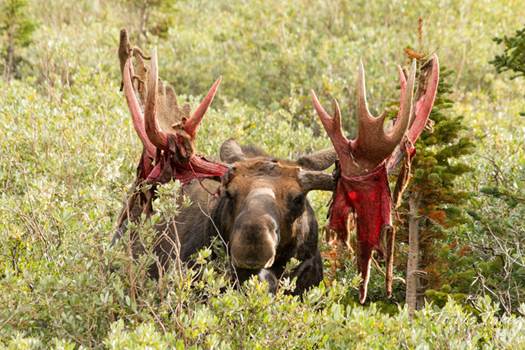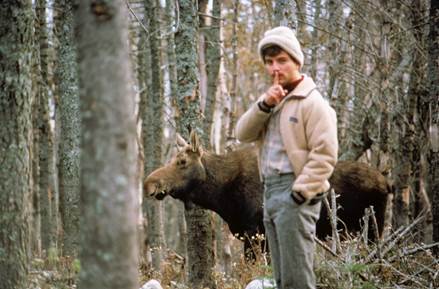Every creature is better alive than dead, men and moose and pine trees, and he who understands it aright will rather preserve its life than destroy it. —Henry David Thoreau
Moose are the largest North American ungulate, or within the deer family. Adults stand 4.5 – 6.9 feet at the shoulder, which is about a foot taller than the next largest North American ungulate, the elk. Males weigh from 800 – 1,500 lbs. while females range from 440 – 1,080 lbs. The length of the body is 7.9 – 10.2 ft. long, so we are talking about a pretty formidable critter here. The record for a bull moose is a reported 2,601 lbs. but this one was not officially authenticated. Only bison are a larger land mammal in North America. The largest official record is 1,808 lbs. from one that was shot in the Yukon in 1897. And when you add antlers that can span close to 6 ft. across – this animal is quite imposing.
Moose migrated across the Bearing Land Bridge during the Illinonian glaciation (191-130,000 years ago) and now display a Holarctic distribution across northern North America, Scandinavia, Latvia, Estonia, and Russia. In North America they are found in Alaska and across Canada, northern New England south to northern New York, the perimeters of Lake Superior, and into Idaho, Montana, Colorado, and northern Utah. In Washington we see moose in the northeast part of the state in Pend Oreille, Stevens, and Spokane County (sometimes) and the occasional wanderer in Whatcom County.
Moose populations in the arctic and subarctic appear to be stable, but at lower latitudes in temperate North America they are on the decline. This appears to be related to global climate changes where winters are not as cold, which results in less mortality of moose parasites, affecting their health.
In England, what we call moose is referred to as an elk. Males are referred to as bulls, females as cows, and youngsters of either sex, a calf. The name moose is thought to have been borrowed from Algonquian languages. Alces – appears to be a Germanic loan-word, essentially referring to elk but applied to a similar looking (to some I suppose) but different animal. Moose is both a singular and plural noun.
Unlike other deer species, moose are solitary and do not form herds. Breeding occurs during the fall with the peak of the rut between September and early October when males and females group together but moose do not form harems, where males control the movement of a group of females, such as what occurs during elk breeding. Antlers are grown and shed each year – growth stops in August and the bull will rub off the outer covering of skin, or velvet. The blood-stained, white antlers darken with age and are eventually shed in November following the rut.

Growing and shedding antlers is a huge energy investment and the healthiest bulls with the largest antlers will pass on their genes. With their large antlers, bull moose will joust for the right to breed. Shed antlers become a source of calcium in the environment are gnawed upon by rodents. On almost any set of shed antlers you find you can see striations from rodent teeth. The gestation period is long – 243 days, and calves are born in May through late June and calves will stay with their mom until the next calf is born while the males go off on their own.
Moose are primarily browsers, feeding on trees and shrubs in the winter. During the summer they often graze on emergent and herbaceous plants and a variety of succulent ends of shrubs and trees. They will wade into ponds and stick their heads in the water to get at plants and tubers. Willow is the most important plant food for moose but they also use balsam fir, quaking aspen, and paper birch frequently. Gray wolf is the most effective predator of moose, hunting in a pack to take down this large animal. Grizzly bear and black bear also will feed on moose. There also have been reports of wolverine, coyote, and lynx taking calves, but this is a unique occurrence. In Alaska, more than 700 moose a year are killed on highways by vehicle collisions. In less you are in a tank, this also is a serious threat to drivers. And if you see a moose – do not approach it!!
These are huge animals and regularly severely injure and kill people. A few years ago a moose and calf wandered onto the University of Alaska – Fairbanks campus and some kids threw snowballs at them. It’s hard to say how this affected its behavior, but it later attacked two people who were not interacting with it, killing one of them. And why would you do this? I think this guy has a beer in his hand: http://www.bing.com/videos/search?q=moose+attack&view=detail&mid=04510944E845BD4BD58104510944E845BD4BD581&FORM=VIRE5
There are exceptions however: http://www.bing.com/videos/search?q=moose&view=detail&mid=D299B84B4161E8335B42D299B84B4161E8335B42&FORM=VIRE1 I
first encountered moose back east in Maine in Baxter State Park in the interior. We hiked into the base of Mount Katahdin (terminus of the Appalachian Trial) slept there two nights and scrambled up the peak. Moose were all around the several lean-tos where we were required to camp and you had to gingerly step around them as they lay in the path to the outhouse. If I knew better back then I would have given them a buffer of 50 yards instead of 2.

I was working in the Beaverhead National Forest one early spring and there was still 6 inches of snow on the ground when I came up over a small ridge and surprised a bull that was lying down. He promptly rose up to his full height of almost 7 ft., gave me the eye and wandered off. Gulp.
I was habitat mapping and after the encounter I caught up with my teammates who were mapping wetlands and I told them about the moose encounter. They didn’t believe me so I dragged them up the ridge to show them the tracks. Yea, yea, they said, and everyone then went back to work.
And folks in the Seattle office – key an eye out for the upcoming Metaline Falls Moose Spotting Contest. Cheers.
